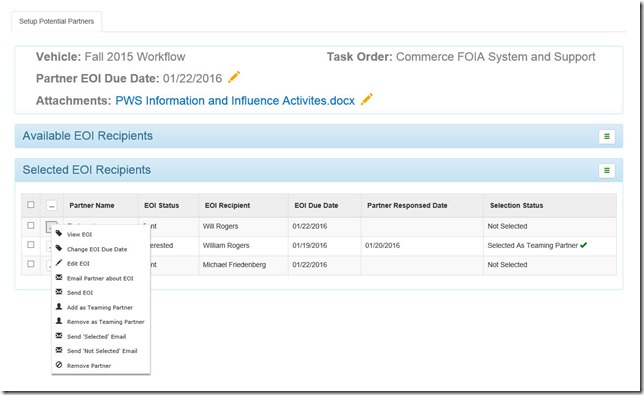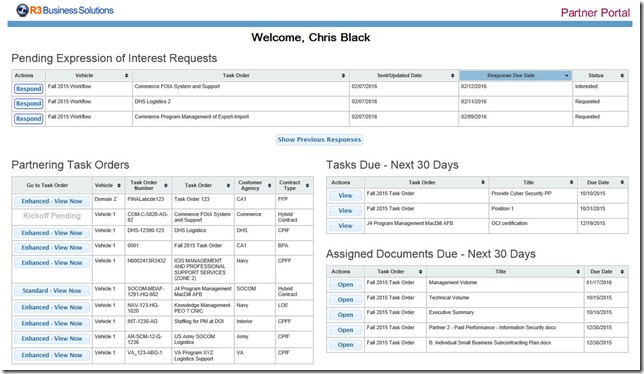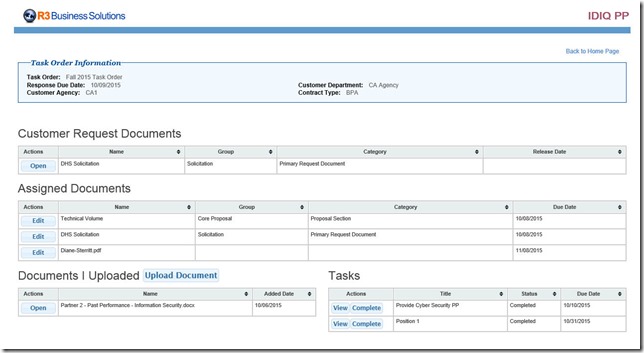Teaming Partners are just about a built-in asset for every Prime on IDIQ multi-award contracts. But not every Prime is truly committed to leveraging them to win business.
Amongst our customers it varies. New Small Business Primes are almost always very committed. Their Teaming Partners are really a necessity to providing customer coverage and having the scope and scale to bid, win and deliver. Our Mid-Tier customers also tend to be committed on most of their vehicles for the same reasons. Although their commitment tends to be stronger on agency-specific IDIQ vehicles in agencies core to their business. Our large customers vary considerably based upon the vehicle and the question of commitment tends to rest with each Program Manager and/or Business Group.
R3 is strongly behind the “committed” camp. The R3 IDIQ Task Order Management system is designed for those organizations that are truly looking to leverage partners. Unlike other vendors’ offerings, it supports engaging with partners across all phases of the Task Order process including pre-bid decision work and in the proposal response. We strive for a rich interactive relationship that is efficient for the Prime and the partner.
In this article, I will describe some key “moments” in partner engagement and I’ll drill down into key features of our solution that support this work.
Key Moments in Partner Engagement
You need to properly onramp partners in the beginning of the relationship. And, post-award you need ways of working with them. But, the key point of partner leverage and engagement comes in the middle. There are in fact two key moments of engaging with partners on Task Orders: the Partner Survey (Expression of Interest) and the Proposal Response.
- The Partner Survey is when you have received a Task Order (or better yet pre-release) and want to survey partners about their interest and their capabilities. Here you are looking for past performance, customer knowledge and how the partner can help you in your solution, on your price and in the work of creating your proposal and winning the business.
- This activity leads to you making a bid decision and selecting one or more teaming partners.
- Then, you are into the Proposal Response. The clock is ticking. This needs to be a very efficient process. If teamed on the Task Order you want the Partner tightly integrated into your proposal effort.
This simple schematic depicts these special moments. The important point of this schematic is that while the two activities occur in different phases with a Bid Decision gate between the phases, the work of engaging with the partners is a continuous process. The information needs to be transparently shared. The work should be seamless.
Perhaps this is obvious to you. Great. However, in many organizations in fact they have a big gap between these two parts of partner engagement. They often have one system for the front-end (pre bid decision), and then, a second system for the back-end (post bid decision) to work on the proposal response. This is particularly true in larger organizations. One consequence is that they rarely end up bidding on more than 10% of the Task Order opportunities that are identified.
Our smaller and mid-tier customers are looking to bid on 50% or more of the Task Orders of their IDIQs. On agency-specific IDIQs that are core to their business, in many cases they are looking to bid 100% of the Task Orders with partners involved 50 to 100% of the time. In this situation, partners are critical, efficiency is key to operational success, and, having a tight, integrated way of working is what drives it all.
How we do this in the R3 Solution
We start with the premise that your work on Task Orders is all part of one integrated, Phase-based process that needs to support all of the work and information in one system. I will very briefly explain how we accomplish this for the key moments in partner engagement and I’ll show you a few screenshots.
Prime and Partners: Two sides of the same coin
A key design element of how we do what we do is to have a separate, secure Partner Portal. The partners work in the Partner Portal and see just the information and do just the work that you enable them to do. The Prime employees work on the “inside” of the system. Thus, you have two parties, interacting through their different interfaces. It is like two sides of the same coin. There are two reasons for this. First, it allows you to separately brand and “accessorize” your Partner Portal. This becomes your public facing gateway for working with partners. Second, you can optimize the work for both groups – the benefit of having two separate interfaces.
Partner Survey (EOI)
During the Bid Assessment phase we have a feature called the Partner Survey Expression of Interest (EOI). The screenshot below shows the Partner Survey EOI console for a single Task Order. You use this to drive the work and interact. It lets you set up the EOI, select the partners you want to survey and then send out the survey. An email goes to the Partner with some information (no attachments) and takes them to the Partner Portal for them to respond.
The screenshot shows a number of actions that the Prime can take. These are for managing your interaction with the partner during this phase. You’ll be evaluating responses, interacting and ultimately select a teaming partner – all from here.
Partner Portal (EOI Response)
Now, let’s look at the Partner Portal. Below is a screenshot of the Partner Portal (generic, unbranded). This is showing the information for a single partner. At the top you see Pending Expressions of Interest. From here the partner can access information about the Task Order and prepare and submit their response. The response is submitted through the system (not email) and is automatically reflected in the EOI survey console for use by the Prime.
Now, look at the screenshot again. At the bottom are the Partnering Task Orders. This shows the Task Orders for which the partner has been selected as the teaming partner. The Tasks Due and Documents Due sections show activity across all of the Task Orders they are working on.
Note that there are different types of buttons in the Go to Task Order field (such as Enhanced, Standard and Kickoff Pending). When the Prime decides to select a teaming partner they can control the level of engagement with that partner. Out of the box we support 4 levels of engagement. The level of engagement determines what information they have access to and what the partner can do.
Partner Working On Task Order Proposal Response
If the partner clicks on the Go to Task Order button for a Task Order they go to the working page for that Task Order as shown below. Here they engage with the Prime. This Task Order is in the Enhanced mode of engagement. It allows the partner to see customer documents, assigned documents, and tasks and data calls. They can open certain documents read-only, and work in co-author mode on others. They can view, act and complete tasks. And they can upload documents in response to data calls.
On the Prime side of the system, they can drive this activity to the partner(s) and see and act with the results.
Gaining Leverage with Partners
As shown above, the R3 IDIQ Task Order Management system supports tight integration between the Prime and the Partner for both the Partner Survey (EOI) and the Proposal Response. It is also designed to be very efficient and streamlined. With this level of system integration the ad hoc emails and communications tend to mostly fade away. The work that is done is automatically in the system and becomes part of the permanent record for each Task Order.
What I’ve shown you is really just a primer. The partner engagement features of our software are designed to be unusually flexible. For those companies really looking to leverage partners (or subcontractors in the case of construction MATOCs) there are many ways to enhance the system to optimize your way of working. You can even have different ways of working for different IDIQ vehicles. The key is to enable you to leverage partners to drive your distinct competitive advantage.





